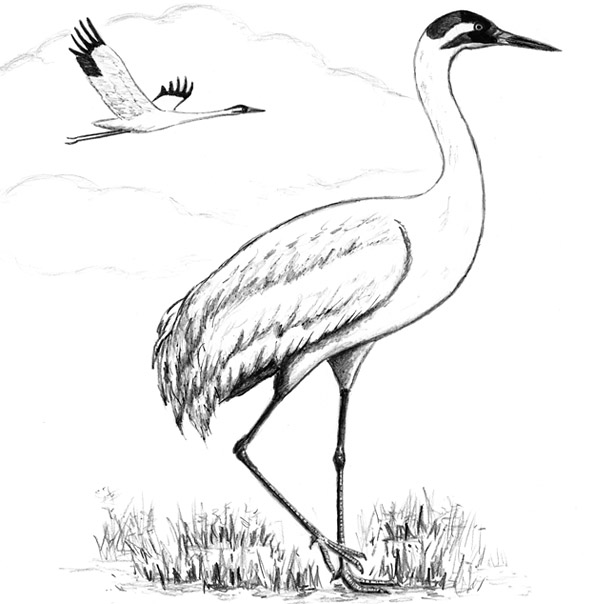
Dear Bird Folks,
After reading the news about a Sandhill Crane being seen feeding on a Provincetown (MA) soccer field, I started wondering about their cousin, the Whooping Crane. I remember there once was a time when Whooping Cranes were nearly extinct. Are they coming back? Do you think there’ll ever be a day when one of them might also find its way to a soccer field in Provincetown?
– Marie, Truro, MA
I don’t think so, Marie,
I doubt very much that you’ll ever see any Whooping Cranes hanging out in a Provincetown soccer field. Whooping Cranes hate soccer and want nothing to do with it. Even though they have decent kicking skills, cranes are slow runners and every time they try to “head” the ball, they run the risk of piercing it with their long, sharp beaks. Have you ever tried to pry a soccer ball off the beak of a Whooping Crane? It’s not as easy as it sounds. In addition, soccer fans often blow those crazy horns called “vuvuzelas.” (Remember those annoying things from this year’s World Cup?) Vuvuzelas are not only annoying, but they also sound very much like the Whooping Crane’s mating call. It’s impossible for the birds to concentrate on the game when they hear mating calls coming from the stands. It’s a problem. Just ask A-Rod.
I understand why you would like to see a Whooping Crane. They are huge, stately birds. They weigh almost seventeen pounds, have a seven-foot wingspan and stand five feet tall. Think about that. There are free-flying birds that are nearly as tall as many adult humans. Most of us could slow dance with a Whooping Crane and not have to bend over. In fact, for a brief time in the ‘50s, Mickey Rooney was actually married to a Whooping Crane.
Whooping Cranes were indeed close to extinction. In the early 1940s, there were only sixteen wild Whooping Cranes left in the entire world. That’s right, only sixteen, 16, one-six. That’s not a lot of birds. By comparison, on any given day, my wife has more than sixteen pairs of shoes in her closet. And, unlike my wife’s shoes, which seem to multiply overnight, cranes are very slow to reproduce. A young crane does not breed until it is at least four years old. Then, if all goes well, it will lay two eggs, but usually only successfully raises a single chick. That’s not a good formula for a species trying to come back from the brink of extinction.
One of the biggest problems with bringing back Whooping Cranes is that their range is rather limited. They basically live in a few small pockets in the central part of North America. That’s all. There is no secret population in another part of the world ready to replace these birds if they are wiped out. The other problem is that most of the remaining cranes spend the winter in the southern U.S., but nest in northern Canada. Even though their breeding and wintering grounds are protected, anything can happen on the 2,500 miles in between. Storms, power line collisions and idiots with guns have all been real problems for migrating cranes.
I’d like the say that the Whooping Crane recovery is a major avian success story, but that’s not really the case. Today, after decades of hard work and expensive measures, we only have been able to increase their population from sixteen to around 280 cranes. One of the biggest frustrations has been establishing alternative populations. Most whoopers spend their winter in the Aransas Wildlife Refuge along the Texas Gulf Coast. You might not know this, but the Gulf Coast has experienced a few difficulties in recent years. So far, the cranes have dodged the hurricanes and oil spills, but they’ve been lucky. Scientists know that having all of the cranes in one basket is just asking for trouble, but efforts to create secondary nesting and wintering sites have not gone well. The trouble is Whooping Cranes have to be taught how to migrate. Migration is not hardwired into cranes like it is with other birds. They need to be shown what to do and where to go. Attempts to hook up whoopers with migrating Sandhill Cranes didn’t work. The whoopers imprinted on the sandhills and never mated with each other. There was also an attempt to establish a non-migratory flock in Central Florida, with lukewarm results (bobcats ate a lot of them). Recently, a creative attempt has been made to reintroduce migrating cranes into the eastern United States with the help of ultralight planes. Young birds are taught to follow the goofy little planes from a nesting area in Wisconsin to wintering grounds in a restricted part of northern Florida. The jury is still out on this one.
If you really want to see a Whooping Crane, Marie, I think you should forget waiting for one to visit a Provincetown soccer field. Your best bet is to travel to Rockport, TX. That’s where most of the cranes spend the winter. There are several tour operators who will take you to see them. Just don’t start blowing a vuvuzela when you arrive or you might end up having a Whooping Crane try to mate with you. Believe me, that’s not nearly as much fun as it sounds. Just ask Mickey Rooney.